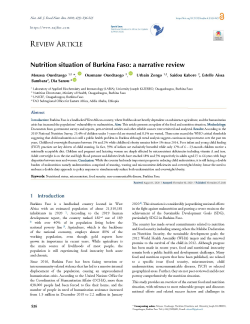Main Article Content
Nutrition situation of Burkina Faso: a narrative review
Abstract
Introduction: Burkina Faso is a landlocked West African country, where livelihoods are heavily dependent on subsistence agriculture, and the humanitarian crisis has increased the populations’ vulnerability to malnutrition. Aim: This article presents an update of the food and nutrition situation. Methodology:Documents from government surveys and reports, peer-reviewed articles and other reliable sources were retrieved and analyzed. Results: According to the 2019 National Nutrition Survey, 25.4% of children under 5 years old are stunted and 8.1% are wasted. These rates exceed the WHO critical thresholds suggesting that child malnutrition is still a public health problem in Burkina although trend analysis suggests continuous improvement over the past ten years. Childhood overweight fluctuates between 1% and 2% while childhood obesity remains below 1% since 2014. Poor infant and young child feeding (IYCF) practices are key drivers of child stunting. In fact, 59% of infants are exclusively breastfed while only 17% of 6 – 23 -month children receive a minimally acceptable diet. Children and pregnant and lactating women are deeply affected by micronutrient deficiencies including vitamin A and iron. Adult overweight is on the rise and high blood pressure and diabetes levels have reached 18% and 5% respectively in adults aged 25 to 64 years with huge disparities between men and women. Conclusion: While the country had made important progress in reducing child malnutrition, it is still facing a double burden of malnutrition namely undernutrition comprised of stunting, wasting and micronutrient deficiencies and overweight/obesity, hence the need to embrace a double duty approach to policy response to simultaneously reduce both undernutrition and overweight/obesity.





